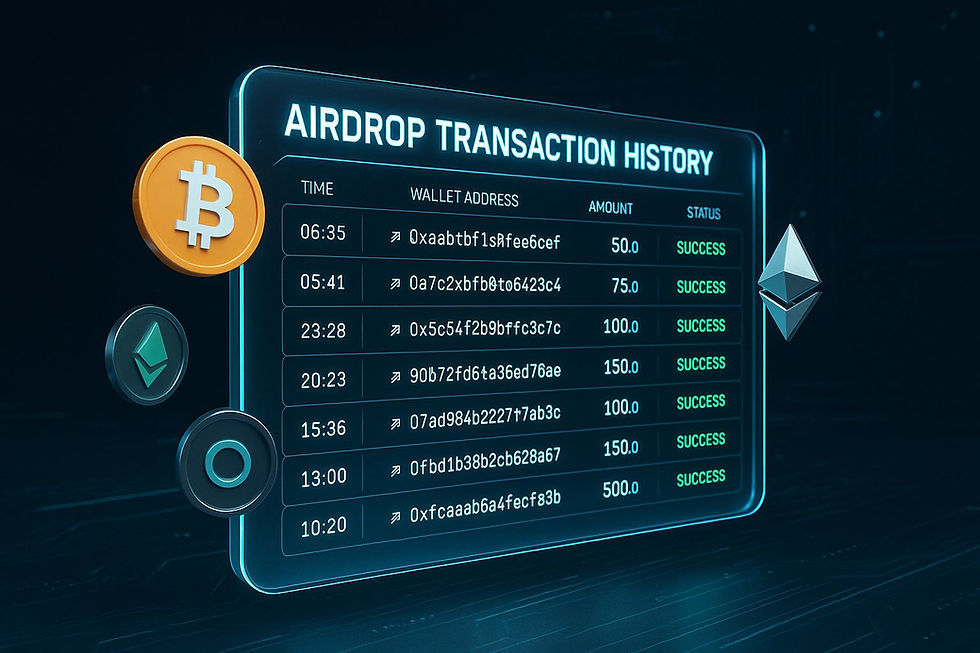How to Check Airdrop History in Crypto: Complete Tracking Guide
- The Master Sensei

- Sep 8
- 5 min read
Crypto airdrops are free token distributions that a lot of investors receive as part of promotions or community rewards. If you want to manage your portfolio or stay on the right side of tax rules, tracking these airdrops is a must. You can check your airdrop history by popping your wallet address into blockchain explorers like Etherscan or BscScan—these sites show detailed transaction records, including airdropped tokens.

Plenty of wallets now have built-in tools that organize and notify you about incoming airdrops, making life a bit easier. If you’re juggling assets on different blockchains, dedicated tracking platforms can pull it all together so you can see both claimed and unclaimed airdrops in one place.
How to Check Airdrop History in Crypto
So, where do you even start? Finding records of airdrops means reviewing your transaction details on different platforms, checking across blockchains, using your wallet’s features, or leaning on specialized tools to see what’s landed in your wallet.
Methods for Reviewing Airdrop Transactions
Start by digging through your wallet’s transaction log. Every transaction tied to your address will show incoming tokens, which might include airdrops. Look for entries with zero fees or ones labeled "airdrop" or "reward" in the notes.
Manual review is doable through wallet interfaces or blockchain explorers, though it can be a slog if you’ve got a busy wallet. Sorting token receipts by date or source can make it a bit less painful to confirm which tokens came from airdrops.
Some folks keep spreadsheets to track details—token names, dates, amounts. If you’re dealing with tokens from multiple projects or blockchains, this can really help keep things straight.
Tracking Airdrops Across Supported Blockchains
Your airdrop history really depends on which blockchain the tokens landed on. Each chain has its own explorer for checking wallet transactions. You’ve got Etherscan for Ethereum, BscScan for Binance Smart Chain, and PolygonScan for Polygon, just to name a few.
To track an airdrop, enter your wallet address into one of these explorers and scan for incoming token transfers. You’re looking for transfers without fees or those linked to airdrop events announced by projects.
If your wallet works across several networks, you’ll need to check each one. And since some airdrops require you to claim them on the project’s website, it’s smart to follow official updates to confirm your eligibility and claim status.
Using Wallets and Blockchain Explorers
Most modern crypto wallets show transaction histories, including airdrops. Wallets like MetaMask or Trust Wallet list incoming tokens by date and amount, so it’s pretty easy to spot new airdrops.
Blockchain explorers dig deeper—they show token contract addresses, sender info, and timestamps. That extra data helps you figure out if you got an airdrop or if it was something else entirely.
You can filter transactions by token type or source to make things easier. Explorers also let you export transaction data, which comes in handy for taxes or keeping your portfolio organized.
Leveraging Airdrop Aggregator Tools
Airdrop aggregator tools gather data from multiple blockchains and show your airdrop history all in one spot.
These platforms often offer alerts for new or unclaimed airdrops, show portfolio values, and even help with tax reporting. They make tracking airdrops a lot less tedious by showing everything—past and present—in one dashboard.
Some examples are Gate and AirdropScan. You just connect your wallet address (securely, of course) and get a comprehensive airdrop report without having to check every blockchain or project site yourself.
Best Practices for Airdrop Tracking and Security
Good airdrop tracking means staying organized, being cautious, and keeping up with the latest info. Protect your assets, keep clear records, and stick to trusted sources for new airdrop opportunities. These habits go a long way toward safer participation and better portfolio management.
Identifying Scam Airdrops
Scam airdrops usually promise free tokens but actually want your private keys or personal info. To steer clear, only trust official project websites and verified social media. Never, ever share your private keys or passwords.
Watch out for airdrops that ask for upfront payments, pushy marketing, or don’t provide clear info about the project or team. Checking community forums and reputable crypto news can help you spot the fakes.
Stick with reputable tracking tools and blockchain explorers to verify token transfers. If you claim an airdrop and the tokens don’t show up on the blockchain, that’s a big red flag. Basically, stay skeptical and double-check everything to avoid scams.
Maintaining a Manual or Portfolio Log
Keeping a manual record or using a portfolio tracker really helps with airdrop management. Jot down the token name, amount, blockchain, and date you got it. This is especially useful if you’re tracking airdrops on Ethereum, Binance Smart Chain, or DeFi protocols.
Spreadsheets or portfolio tools let you sort by value, project, or vesting schedule. Good logs make tax reporting easier too, since airdrops often count as taxable income.
If you combine manual logs with automatic tracking from wallets or exchange platforms, you’ll have a complete and current airdrop history. That helps you decide whether to hold, sell, or stake your tokens.

Staying Informed About New Airdrops
If you want to catch new airdrops, follow reliable sources and official channels. Subscribe to project newsletters, join legit crypto forums, and keep an eye on airdrop listing sites.
Social media from trusted projects and DeFi platforms often announces airdrops early. Avoid sketchy sites promising quick tokens without any real info.
Regularly check blockchain explorers and tracking tools so you don’t miss out. Getting involved in DeFi communities and governance forums can also reveal airdrops tied to participation or staking.
Frequently Asked Questions (FAQs)
To check airdrop history, you’ll need to look at wallet transactions, use blockchain explorers, and maybe try out specialized tools. It’s also about confirming token receipts and knowing if your wallet offers notifications.
What steps are involved in viewing past transactions of received airdrops on popular wallets?
Open your wallet’s transaction history and look for incoming token transfers. Many wallets highlight airdropped tokens or show transactions with zero fees—that’s often your airdrop. Some wallets also group tokens by type, which makes them easier to spot.
Can I trace the origin of my airdropped tokens within blockchain explorers?
Absolutely. Enter your wallet address on a blockchain explorer like Etherscan or BscScan, and check the transaction details. You’ll see where the tokens came from, including the contract address or sender, which helps you figure out the airdrop source.
Is it possible to retrieve a history of airdrops on decentralized platforms?
Yes, decentralized platforms record every transaction on the blockchain. Search your wallet address in the relevant explorer, and you’ll see airdrops tied to those platforms. Sometimes you’ll need to manually claim airdrops from a project’s official site, though.
How can one confirm receipt of airdrops in their cryptocurrency wallets?
Check your wallet’s token balance or transaction list. Many wallets send notifications for new deposits. You can also double-check on a blockchain explorer to see if the tokens officially arrived.
What tools or applications can assist users in tracking their airdrop history?
Blockchain explorers and wallet apps with transaction history views are solid options. There are also dedicated platforms that focus on airdrop tracking, offering consolidated histories, alerts, and portfolio features.
Are there any automated services to notify users of incoming or past airdrops?
Yeah, actually. Certain wallets and a handful of third-party tools keep an eye on blockchain activity and send out alerts when new tokens land in your wallet. These services let you know about airdrops you qualify for or just received, so you don’t have to worry about missing out.
















































Comments